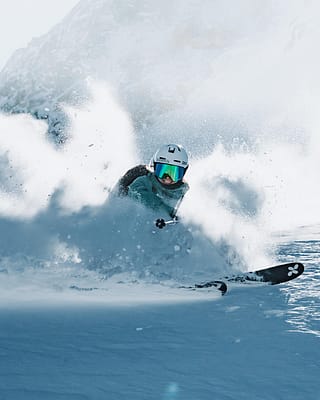How to ski in powder
Skiing in powder is a different beast from lapping the groomers. So if you’re looking for some extra advice on adding pow slashing to your bag of tricks, read on.

Everyone prays for a powder day. And sure, any pow lap is a good lap! But when you see some hooligan cutting a gnarly line through the trees or popping off some choice boulders and throwing face shots for fun, you can’t help thinking: darn, I wish I could do that! Well, you can.
We may not be pros, but we’ve gathered the best tips and tricks to help you take your skiing to the next level. Pow will become your playground, and fresh tracks the only currency you deal in. Ready to make the most of the next snowfall?
Putting your skills on display is one thing, but rocking a sick outfit while you rip for cheers on the lift makes it even more fun. So if you’re ready to upgrade your ski jacket or ski pants before the season is done, check out our range!
Quick find navigation
Wie unterscheidet sich Tiefschneefahren vom Skifahren auf der Piste?
Die Verhältnisse richtig einschätzen
Die Wahl deiner Line
Kurvenfahren und Geradeausfahren
Gewichtsverlagerung
Gleichgewicht und Körperhaltung
Geschwindigkeit halten und gelassen bleiben
Die richtige Ausrüstung
How is powder skiing different from skiing on groomers?
The first question you might ask is how powder skiing differs from riding the corduroy. And that’s totally valid! The major difference is that groomer riding requires you getting on edge to initiate a turn, which can be held with body positioning and leg tension.
Pow skiing relies a little more on rhythm and feeling. Not to get too wishy-washy about it, but you really have to feel your way through the powder, making smooth, easy moves, bouncing, and cutting your way to the bottom. ‘How do you do this?’ you ask. Well, get comfy because we’re about to walk you through it step by step.

Reading the conditions
Not all pow is created equal. Depending on the conditions, it could be champagne powder or that heavier, slushier stuff. It may also be waist-deep or just a light dusting. These things factor into how you ride. Light, fluffy, deep powder, for example, will require more exaggerated weight shifts to really get those bases up, but an overall smoother turn initiation that’s made earlier. This is because you’ll be displacing lots of snow under your bases before you compact it enough for it to push you into the turn.
Contrarily, if it’s heavier stuff, you’ll have to make more deliberate, powerful moves to displace all that heavy snow, but be ready for it to push back pretty hard! So, depending on the weight and depth of the snow, you’ll have to adjust how much power you’re putting into your skis, how much you shift your weight, and how soon or late you initiate your turn to stay on-line. Speaking of which …
Line choice
Your line choice should take into account three things for every turn: entry, maneuver, and exit. For example, if it’s a tree you’re going around, are you going to the left or right of it? As you turn, will you be turning down or across the hill? What’s on the other side of it? Do you have enough time to link another turn together, or do you need to straight-line?
Everyone will see a different line through the snow depending on their skill level and preference (avoiding cliffs or jumping off them, for example!). Still, it’s always imperative to remember that you’ll need more space to slow down and turn in the powder than you would on the groomers. Quickly digging in an edge isn’t so easy in pow!

Turning and straight-lining
Powder riding can be broken down into turning and straight-lining. Where are you turning, and where are you riding straight? A turn will maintain momentum, while straight-lining will gain you speed. Of course, you don’t need to straight-line on the fall line. Traversing between turns is a great way to take a moment to assess the terrain ahead and pick your line.
Turns in pow often take a lot more time than you expect, too, so making those adjustments to your line choice is important. The tighter the environment, the slower you should ride. And remember, never straight-line through the trees, no matter how confident you feel. The key is to link your turns smoothly. And you can do this by …
Weighting and unweighting
You might notice that more advanced riders look to ‘bounce’ through the snow when linking those turns. While leaning back is a bit of a no-no for pow skiing, you’ll need to utilize your body weight, pushing down into your skis to displace more snow and really put some bend in that wood!
This ‘loads’ the ski, and when it pushes back, it will spring you upwards, giving you some extra float. So, if you can load through your turns and float through your links, you’ll throw pow shots with the best of them in no time.

Balance and body positioning
It can be tricky to nail this right away, so it’s good to work on your balance and body positioning. For powder — and this is counter-intuitive — you don’t need to lean back all that much. If you do, you’ll find the tails of your skis will likely slide out as you turn, and you’ll basically have no control over them.
Keeping your weight central in the skis, your knees bent, and your body perpendicular to the grade of the ground will help to keep your composure through turns. And it’ll help to get that ‘bounce’ technique down.
Maintaining speed and composure
In powder, the faster you ski, the more you’ll begin to ‘plane’ along the surface. This is totally magical! But it also comes with its own repercussions. The faster you’re going, the larger your turn radius will be, so it’s important to maintain your speed with regular turns. Maintaining speed is the best way to stay safe, keep a good rhythm to your bounces, and stay on-line.
Keeping your composure is another important aspect of powder riding. Sometimes, you’ll either find your line choice is a little hairier than expected, or you’ll have to straight-line out of something and will go a touch faster than you want. Keeping a cool head in these situations, assessing the terrain, and looking for a good place to shrug off some speed with a nice smooth turn is always the right decision.

Get the right equipment
If powder skiing is something you’re looking to get into more seriously, you might consider some powder-specific skis. They generally feature a hybrid camber profile (camber underfoot with rockered tips for better float) and a wider base for better displacement and turning.
No matter your skill level, alpine skis will never fare well in deep powder. They’re just not designed for it! So, finding the right equipment for the task at hand is imperative for really excelling as a powder rider.
Wrapping up
Well, that’s our best advice for riding into the deep stuff. Not an exhaustive guide by any means, but enough to get you thinking and hopefully make your journey into the slack, side, or backcountry that much safer and more enjoyable. Now, do the snow dance, cross your toes, and pray for pow!
Related reading:
